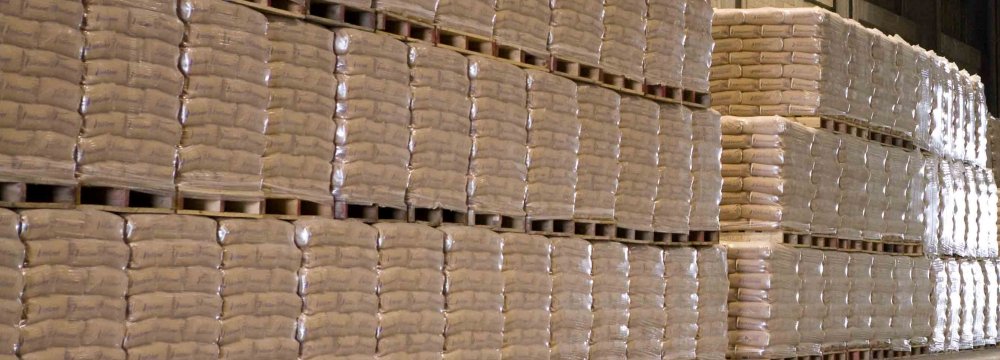
Cement Industry Mulls Options to Sustain Domestic Demand

The Iranian cement industry is in hot waters. It has recently been hit with the double whammy of loss of export markets and lack of domestic demand, causing producers to cut down on production and limit expansion projects.
Various solutions have been proposed by officials and experts. They include providing subsidies to pay for the transportation costs of exporting to new markets, banning the establishment of new plants due to overcapacity and using concrete instead of bitumen in road and pavement construction to create demand.
The Ministry of Industries, Mining and Trade’s main focus has been on the latter solution, as it has pushed for marketing the product for road construction by teaming up with the Ministry of Roads and Urban Development.
With the same purpose, Cement Employers Association has called for holding expos on concrete road construction and related production machinery to familiarize industrialists with the new practice.
The Ninth International Exhibition of Cement and Concrete Manufacturing Technologies and Related Machineries, also known as Iran Cementex 2017, opened in Tehran on Saturday and will run through Tuesday with this aim in mind.
The expo is attended by all the big local names in the sectors, as well as firms from France, Germany, Turkey, China, Finland, Sweden, South Korea, Japan, Armenia and Turkmenistan.
Iran Cementex also held a seminar titled “Development, Design and Establishment of Concrete Structures in Tehran” on the sidelines of the expo, with speakers, including deputy minister of industries, mining and trade, Jafar Sarqeyni, and Minister of Roads and Urban Development Abbas Akhoundi, as well as a host of industry players and faculty members.

Iran is currently the world’s seventh largest cement producer, as it dropped three steps last year due to its plummeting production.
Mixed Opinions
Sarqeyni, who was the seminar’s first speaker, was mostly sanguine that the industry is capable of getting back on track in a few years.
The official emphasized that the ministry is pushing forward with plans to boost cement production capacity to 120 million tons from the current 80 million by the end of 2025, as part of ambitious targets set in the 20-Year Vision Plan (2005-25).
“Currently 74 cement projects are under construction across the country, the completion of which will materialize the envisioned target,” he said.
Akhoundi, on the other hand, was uncompromisingly critical.
“Iran’s cement industry is behind the times,” he said, stressing that the sector’s insistence on capacity-building while foregoing demand stimulation, portfolio diversification and development of marketing strategies have made it uncompetitive.
“Cement’s applications have significantly expanded in modern life. This is while the Iranian cement industry makes use of a very limited number of products,” he said, noting that local producers have been stuck in a loop by simply churning out cement and its raw materials for years, naturally saturating the market and causing a glut.
The way forward, he believes, is to diversify products.
The minister also criticized the producers’ lack of “commercial logic” and their overdependence on state support.
“The government is taking all possible measures to stimulate demand. But for that to be effective, you [producers] must first be able to market your products and develop distribution strategies,” he said.
Cement producers and exporters have been slammed on different occasions for their lack of proper understanding about international trade practices.
According to Keyvan Jafari Tehrani, the head of International Affairs Department of Iran Economy House, exporters are often unable to comply with strict delivery timetables and reimburse the buyer in case of low product quality, causing them to lose potential markets.
“Incredibly Difficult” Target
Akhoundi also cast doubt on the Industries Ministry’s capacity expansion plan due to the persistent market glut and said the Vision Plan target will be “incredibly difficult” to achieve unless the producers’ mindset and domestic market dynamics change.
Nevertheless, the Ministry of Roads and Urban Development is planning to boost domestic demand for cement by purchasing excess output through letters of credit issued in cooperation with Bank Maskan. The industrial material will be used in the construction of runways, roads and buildings.
Just like the officials, domestic and foreign participants in the expo had mixed opinions about the Iranian cement industry. Foreign players were mostly optimist newcomers dipping their toes in Iranian water, while local companies struggled with the prevalent woes and expressed skepticism over its improvement.
“Iran has a considerably big cement market with a lot of potential [for foreign companies]. We have zero record in Iran and have just entered to use this potential,” Chris Zhang, sales manager of Qinghua Refractories, told the Financial Tribune on the sidelines of the expo.
Located in northeastern China, the company is a basic refractory manufacturer with an annual production capacity of over 2 million tons per year. Made from magnesia, the company’s products are used in furnaces.
Chinese firms’ late entry into Iranian cement market, according to Zhang, is mostly due to the particular nature of “Chinese business culture”, which causes company managers to be conservative in investing in new, uncharted markets.
The Chinese unfamiliarity with the international business environment also reinforces this notion.
Zhang emphasized that the Iranian market is set to become even more promising for foreigners as the remaining financial impediments of sanctions fade in a few years.
“And our competitors are already here, so we have to move fast,” he said.
Melike Yildirim, international trade manager of the Turkish TUNELMAK, and Marko Isojarvi, managing director of Finland’s Steel-Kamet Oy, also shared the same view. Both companies have just hired agents in Iran and are monitoring the market.
On the other hand, Edris Frounchi, an official with Ilam Cement Company, told Financial Tribune that local producers have yet to feel the impact of the government’s supportive policies.
“Prices are still depressed, no cement exports to Iraq take place and we have not yet heard about any transportation subsidies for new markets,” he said.
Frounchi noted that his company only exports clinker, the main raw material used in cement production, in low quantities to Iraq.
Iran is currently the world’s seventh largest cement producer as it dropped three steps last year due to plummeting production.
Production reached 58.6 million tons in 2015, down 12% year-on-year, according to CEA data.
More than 15 million tons of cement and clinker were exported in the last Iranian year (ended March 19, 2016), with Iraq accounting for close to 65% of the figure. Exports dropped markedly in April, after the Iraqi government imposed a ban on cement imports to support its domestic sector.


Trump weighs using $2 billion in CHIPS Act funding for critical minerals

Codelco cuts 2025 copper forecast after El Teniente mine collapse

Electra converts debt, launches $30M raise to jumpstart stalled cobalt refinery

Barrick’s Reko Diq in line for $410M ADB backing

Abcourt readies Sleeping Giant mill to pour first gold since 2014

Nevada army depot to serve as base for first US strategic minerals stockpile

SQM boosts lithium supply plans as prices flick higher

Viridis unveils 200Mt initial reserve for Brazil rare earth project

Tailings could meet much of US critical mineral demand – study

Kyrgyzstan kicks off underground gold mining at Kumtor

Kyrgyzstan kicks off underground gold mining at Kumtor

KoBold Metals granted lithium exploration rights in Congo

Freeport Indonesia to wrap up Gresik plant repairs by early September

Energy Fuels soars on Vulcan Elements partnership

Northern Dynasty sticks to proposal in battle to lift Pebble mine veto

Giustra-backed mining firm teams up with informal miners in Colombia

Critical Metals signs agreement to supply rare earth to US government-funded facility

China extends rare earth controls to imported material

Galan Lithium proceeds with $13M financing for Argentina project

Kyrgyzstan kicks off underground gold mining at Kumtor

Freeport Indonesia to wrap up Gresik plant repairs by early September

Energy Fuels soars on Vulcan Elements partnership

Northern Dynasty sticks to proposal in battle to lift Pebble mine veto

Giustra-backed mining firm teams up with informal miners in Colombia

Critical Metals signs agreement to supply rare earth to US government-funded facility

China extends rare earth controls to imported material

Galan Lithium proceeds with $13M financing for Argentina project

Silver price touches $39 as market weighs rate cut outlook

















